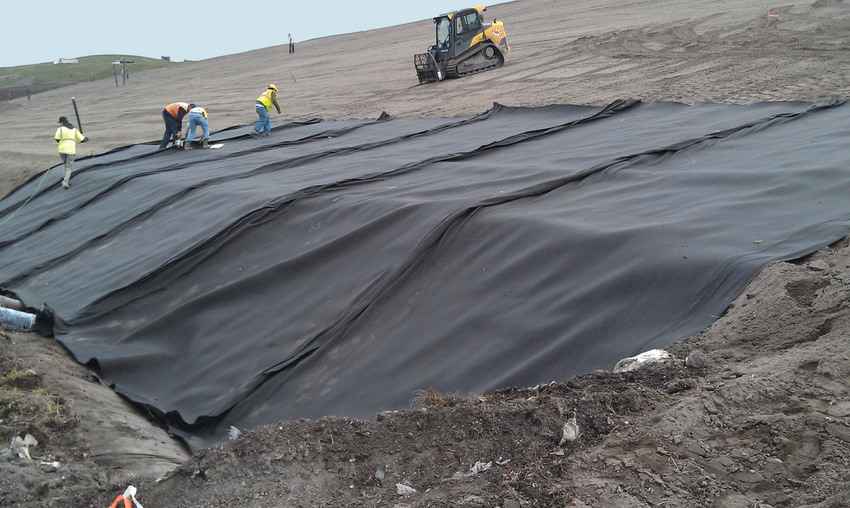Landfill cap design is site specific, depending on the system’s required function, with region being key.

Landfill caps play critical roles in waste management, coming with operational and, sometimes, revenue-generating benefits. They control leachate and odor, reduce emissions and facilitate gas capture. As part of the gas management system, in particular, caps are especially instrumental during cell closure and they can impact the bottom line for operators capitalizing on landfill gas to make fuels.
Meanwhile, improved technologies are increasing their value and practicality, including applications from exposed, temporary geomembrane caps to a system called ClosureTurf. Each has unique features that have new benefits or bolster existing ones. They also have one common denominator; they all typically require less maintenance than traditional soil caps.
Aging landfills affect containment systems.
“As waste degrades, landfills settle and leachate concentrations change. We are learning how these factors affect caps and how they behave. And we are learning what to change for better efficiency,” says Michael Stubbs, president of engineering firm Hodges, Harbin, Newberry and Tribble in Macon, GA.
Landfill cap design is site specific, depending on the system’s required function, with region being key. For instance, a one-layer system of soil is typically sufficient in dry climates, while a multi-layer design of soils and geosynthetics is required in wet climates. Composite barriers leverage the properties of both material types: the geomembrane’s impermeability and the soil’s ability to prevent heavy leakage into waste.
Soil cap vs. geomembrane cap
The industry is finding that while for intermediate slopes traditional soil caps adequately control storm water, odor and leachate, geomembranes are more efficient.
“Geomembrane caps are drastically improving odor control and further decreasing leachate generation. They prevent sedimentation and erosion in the area they cover, meaning less maintenance of slopes and avoiding installation of additional storm water controls,” says Stubbs.
These synthetic structures are sometimes temporary, eventually replaced with final cover. The temporary cap allows recovery of airspace. When the landfill settles, operators simply remove the membrane and recover that space.
Exposed temporary caps are not inexpensive. But the investment can typically eventually be recovered in improved operational efficiencies, according to Stubbs.
“We are seeing more systems incorporating temporary geomembrane caps and learning, by installing them upfront, we offset expense by reducing long-term maintenance.”
Temporary geomembrane caps do have potential drawbacks. There may be additional permitting requirements, and some states expect operators to engage in a demonstration project as these products are fairly new.
A new system
Another new system that’s garnering industry attention is ClosureTurf. With a geomembrane, drainage layer, and artificial grass on top, this branded product permanently caps the landfill to contain waste, control gas emissions, and manage storm water runoff. It’s sold as an alternative to subtitle B final cover.
Some of its early users like its aesthetic appeal—while traditional cap systems have areas that are not well vegetated, resulting in bare and brown spots, ClosureTurf provides 100 percent coverage. And the artificial grass surface lasts for decades.
“ClosureTurf is not common at this point. It’s a new product so [as is often the case with exposed geomembranes] states may require demonstration projects. I think it will gain more acceptance as regulators become more comfortable with them, as landfills learn how they can fit in with operations, and as engineers gain more experience at designing and installing them,” says Steve Menoff, senior vice president of Civil and Environmental Consultants in Pittsburgh.
Materials that last
Materials are making a difference, especially as far as their ability to stand up to stress. Bentonite-polymer composites are among those proving effective at enabling caps to endure harsh natural and synthetic elements.
“Caps are interacting with the atmosphere, as they are at the surface. When this happens, there is a fluctuation between wet and dry and freezing and thawing, which can be destructive. But we are finding that by incorporating materials like these into caps they become resistant to both atmospheric conditions and to many aggressive chemical environments,” says Craig Benson, dean of Engineering at the University of Virginia in Charlottesville, Va., and a waste management consultant.
Putting a dent in maintenance costs
All caps require some maintenance –one of landfill operators’ largest money and time expenses.
The industry does not yet definitively know the maintenance requirements for the newer alternatives to traditional covers. The products haven’t been around long enough. But with their known maintenance issues, primarily related to erosion and drainage features, traditional soil caps will likely prove more work than newer alternatives, says Menoff.
About the Author(s)
You May Also Like




